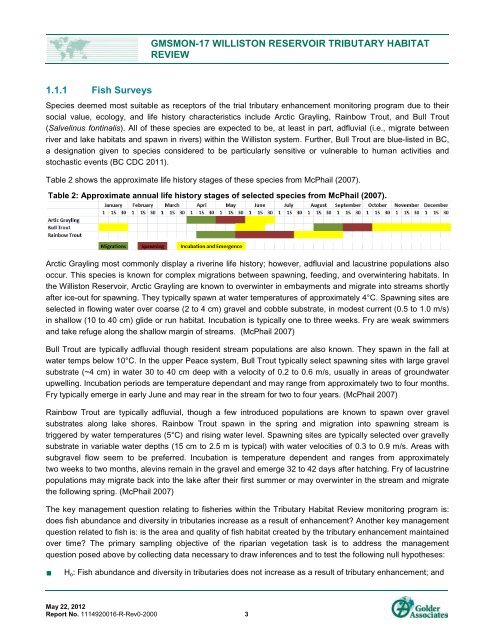GMSMON-17 WILLISTON RESERVOIR TRIBUTARY - BC Hydro
GMSMON-17 WILLISTON RESERVOIR TRIBUTARY - BC Hydro
GMSMON-17 WILLISTON RESERVOIR TRIBUTARY - BC Hydro
You also want an ePaper? Increase the reach of your titles
YUMPU automatically turns print PDFs into web optimized ePapers that Google loves.
1.1.1 Fish Surveys<br />
May 22, 2012<br />
Report No. 1114920016-R-Rev0-2000 3<br />
<strong>GMSMON</strong>-<strong>17</strong> <strong>WILLISTON</strong> <strong>RESERVOIR</strong> <strong>TRIBUTARY</strong> HABITAT<br />
REVIEW<br />
Species deemed most suitable as receptors of the trial tributary enhancement monitoring program due to their<br />
social value, ecology, and life history characteristics include Arctic Grayling, Rainbow Trout, and Bull Trout<br />
(Salvelinus fontinalis). All of these species are expected to be, at least in part, adfluvial (i.e., migrate between<br />
river and lake habitats and spawn in rivers) within the Williston system. Further, Bull Trout are blue-listed in <strong>BC</strong>,<br />
a designation given to species considered to be particularly sensitive or vulnerable to human activities and<br />
stochastic events (<strong>BC</strong> CDC 2011).<br />
Table 2 shows the approximate life history stages of these species from McPhail (2007).<br />
Table 2: Approximate annual life history stages of selected species from McPhail (2007).<br />
Arctic Grayling most commonly display a riverine life history; however, adfluvial and lacustrine populations also<br />
occur. This species is known for complex migrations between spawning, feeding, and overwintering habitats. In<br />
the Williston Reservoir, Arctic Grayling are known to overwinter in embayments and migrate into streams shortly<br />
after ice-out for spawning. They typically spawn at water temperatures of approximately 4°C. Spawning sites are<br />
selected in flowing water over coarse (2 to 4 cm) gravel and cobble substrate, in modest current (0.5 to 1.0 m/s)<br />
in shallow (10 to 40 cm) glide or run habitat. Incubation is typically one to three weeks. Fry are weak swimmers<br />
and take refuge along the shallow margin of streams. (McPhail 2007)<br />
Bull Trout are typically adfluvial though resident stream populations are also known. They spawn in the fall at<br />
water temps below 10°C. In the upper Peace system, Bull Trout typically select spawning sites with large gravel<br />
substrate (~4 cm) in water 30 to 40 cm deep with a velocity of 0.2 to 0.6 m/s, usually in areas of groundwater<br />
upwelling. Incubation periods are temperature dependant and may range from approximately two to four months.<br />
Fry typically emerge in early June and may rear in the stream for two to four years. (McPhail 2007)<br />
Rainbow Trout are typically adfluvial, though a few introduced populations are known to spawn over gravel<br />
substrates along lake shores. Rainbow Trout spawn in the spring and migration into spawning stream is<br />
triggered by water temperatures (5°C) and rising water level. Spawning sites are typically selected over gravelly<br />
substrate in variable water depths (15 cm to 2.5 m is typical) with water velocities of 0.3 to 0.9 m/s. Areas with<br />
subgravel flow seem to be preferred. Incubation is temperature dependent and ranges from approximately<br />
two weeks to two months, alevins remain in the gravel and emerge 32 to 42 days after hatching. Fry of lacustrine<br />
populations may migrate back into the lake after their first summer or may overwinter in the stream and migrate<br />
the following spring. (McPhail 2007)<br />
The key management question relating to fisheries within the Tributary Habitat Review monitoring program is:<br />
does fish abundance and diversity in tributaries increase as a result of enhancement? Another key management<br />
question related to fish is: is the area and quality of fish habitat created by the tributary enhancement maintained<br />
over time? The primary sampling objective of the riparian vegetation task is to address the management<br />
question posed above by collecting data necessary to draw inferences and to test the following null hypotheses:<br />
� Ho: Fish abundance and diversity in tributaries does not increase as a result of tributary enhancement; and
















